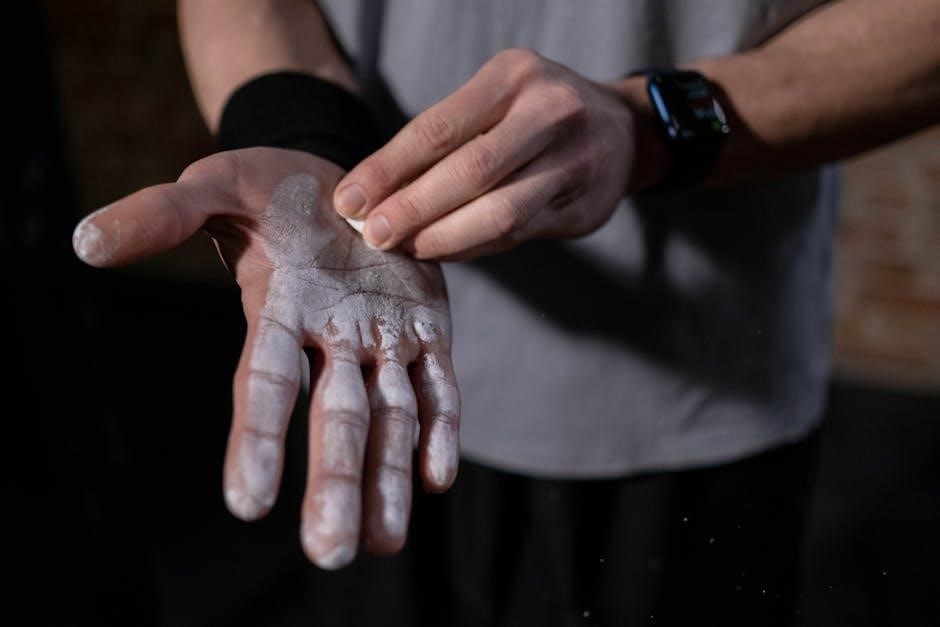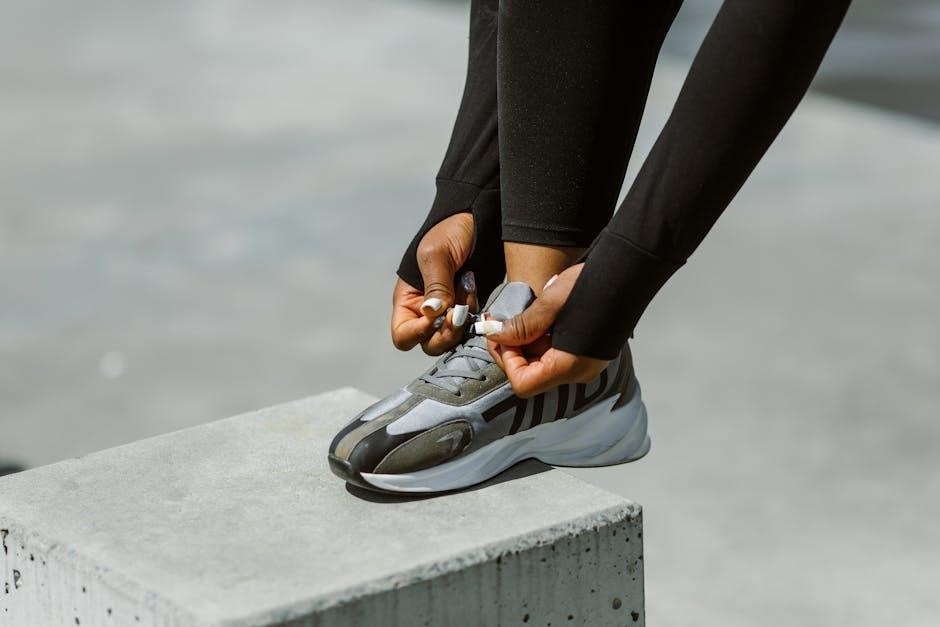Manual Lymphatic Drainage (MLD) training introduces a gentle, therapeutic technique developed by Dr. Emil Vodder to enhance lymphatic flow, aiding in detoxification and reducing swelling. This method involves light, rhythmic strokes to stimulate lymph nodes, promoting overall well-being and addressing conditions like lymphedema. Widely recognized in healthcare, MLD training equips professionals with skills to improve patient outcomes and support post-surgery recovery.
1.1 Historical Background of Manual Lymphatic Drainage
Manual Lymphatic Drainage (MLD) traces its origins to the 1930s, developed by Dr. Emil Vodder and his wife, Estrid, in Paris. Initially created to address swollen lymph nodes, the Vodder Technique laid the foundation for modern MLD. The method gained popularity as a therapeutic approach for detoxification and improving lymphatic circulation. Over the years, MLD has evolved, with advancements in techniques and applications, becoming a cornerstone in lymphedema management and post-surgical recovery. Its historical development highlights the importance of understanding the lymphatic system’s role in health and disease, paving the way for its integration into contemporary healthcare practices.
1.2 Importance of Lymphatic Drainage in Healthcare
Lymphatic drainage plays a vital role in healthcare by addressing lymphatic system dysfunction, which can lead to conditions like lymphedema and impaired detoxification. MLD is essential for managing chronic swelling, reducing post-surgical recovery time, and enhancing overall immune function. It complements traditional therapies, offering a non-invasive approach to improve circulation and toxin removal. Healthcare professionals increasingly recognize its value in patient care, particularly for those undergoing cancer treatments or suffering from lymphatic disorders. By integrating MLD into treatment plans, healthcare providers can offer a holistic solution that promotes healing, reduces discomfort, and improves quality of life for patients with lymphatic system challenges.

Benefits and Importance of Manual Lymphatic Drainage
Manual Lymphatic Drainage (MLD) enhances lymphatic flow, aiding detoxification, immune support, and reducing swelling. It promotes relaxation, improves circulation, and supports post-surgery recovery, making it a valuable healthcare tool.
2.1 Physical Benefits of MLD
Manual Lymphatic Drainage (MLD) offers numerous physical benefits, primarily by enhancing lymphatic circulation. It effectively reduces swelling and edema, particularly in cases of lymphedema, by promoting the removal of excess fluids and proteins. MLD also alleviates pain and discomfort associated with lymphatic congestion. Additionally, it improves overall circulation, boosting the delivery of oxygen and nutrients to tissues. This technique is highly beneficial for post-surgical recovery, as it minimizes scar tissue formation and accelerates healing. Furthermore, MLD supports the immune system by facilitating the elimination of toxins and pathogens. Its gentle, non-invasive nature makes it suitable for a wide range of conditions, from chronic swelling to post-traumatic injuries.
2.2 Emotional and Mental Benefits of MLD
Manual Lymphatic Drainage (MLD) offers profound emotional and mental benefits, fostering relaxation and reducing stress. The gentle, rhythmic strokes create a calming effect, promoting a sense of well-being and tranquility. This therapy can alleviate emotional distress associated with chronic conditions like lymphedema, enhancing overall mental health. By addressing physical discomfort, MLD helps reduce anxiety and depression, improving quality of life. It also encourages self-care practices, empowering individuals to take an active role in their healing journey. Additionally, MLD can improve sleep quality, further supporting emotional resilience and mental clarity. The therapeutic connection during sessions often provides comfort and reassurance, making it a holistic approach to both physical and emotional well-being.

Techniques and Methods in Manual Lymphatic Drainage Training
Manual Lymphatic Drainage (MLD) training encompasses various techniques to enhance lymphatic flow, including gentle strokes, directional pressure, and specialized methods like the Vodder Technique. These approaches, often combined with hands-on practice, are designed to improve lymphatic function and address specific conditions effectively.
3.1 The Vodder Technique
The Vodder Technique, developed by Dr. Emil Vodder, is a cornerstone of Manual Lymphatic Drainage (MLD) training. This method emphasizes gentle, rhythmic strokes to stimulate lymph nodes and enhance lymphatic circulation. It focuses on creating a wave-like motion to guide lymph fluid toward functional nodes, aiding in detoxification and reducing swelling. The technique is particularly effective for conditions like lymphedema and post-surgical recovery. Professionals undergo certification courses to master this approach, ensuring precise application. The Vodder Technique is widely recognized for its therapeutic benefits and remains a foundational element in MLD training programs worldwide. Its effectiveness has been validated through decades of clinical use and research.
3.2 Fluoroscopy-Guided Manual Lymphatic Drainage (FG-MLD)
Fluoroscopy-Guided Manual Lymphatic Drainage (FG-MLD) is an advanced technique that combines traditional MLD with real-time fluoroscopic imaging. This method allows practitioners to visually monitor lymphatic vessels and nodes during treatment, enhancing precision and effectiveness. By observing lymph flow dynamics, therapists can apply targeted strokes to alleviate congestion and improve drainage. FG-MLD is particularly beneficial for complex cases, offering a deeper understanding of lymphatic function. It requires specialized training in both MLD and fluoroscopic interpretation, making it a valuable tool in modern lymphatic care. This innovative approach is gaining recognition for its ability to optimize therapeutic outcomes and address challenging lymphatic disorders effectively.
3.3 Kinesiology Taping for Enhanced Lymphatic Flow
Kinesiology taping is a non-invasive method used to enhance lymphatic flow by applying specialized tape to the skin. This technique, often combined with MLD, works by gently lifting the skin, which reduces pressure on lymphatic vessels and promotes fluid circulation. The tape is applied in specific patterns to stimulate natural movement and support the lymphatic system. It is particularly effective for addressing swelling, edema, and sports-related injuries. By improving lymphatic flow, kinesiology taping aids in toxin removal and accelerates recovery. This method is widely used in physical therapy, sports medicine, and lymphedema management, offering a complementary approach to manual lymphatic drainage techniques.

Applications of Manual Lymphatic Drainage in Healthcare
Manual Lymphatic Drainage is a versatile therapy applied in various healthcare settings. It aids in post-surgery recovery, manages lymphedema, and enhances physical therapy outcomes. By reducing swelling and improving lymphatic circulation, MLD supports overall patient well-being and accelerates healing processes.
4.1 Use of MLD in Post-Surgery Recovery
Manual Lymphatic Drainage (MLD) is a valuable tool in post-surgery recovery, particularly for patients who have undergone lymph node removal or surgeries impacting the lymphatic system. By gently stimulating lymph flow, MLD helps reduce swelling, promote healing, and prevent complications. For instance, Cedars-Sinai has highlighted its benefits in reducing post-operative edema and enhancing patient comfort. MLD is especially beneficial for individuals recovering from breast cancer surgeries or other procedures involving lymph node dissection. When performed by a trained therapist, it can significantly improve circulation and support the body’s natural detoxification processes. This non-invasive technique is increasingly recommended by healthcare professionals to aid in a smoother and faster recovery.
4.2 Managing Lymphedema Through MLD
Lymphedema, a chronic condition characterized by excessive swelling due to impaired lymphatic function, can be effectively managed with Manual Lymphatic Drainage (MLD). This gentle technique helps redirect lymph fluid to functional nodes, reducing swelling and preventing progression. MLD is a cornerstone in lymphedema treatment, complementing bandaging and exercises. Techniques like Fluoroscopy-Guided MLD (FG-MLD) allow precise visualization, enhancing efficacy. Regular sessions with certified therapists can significantly improve mobility and quality of life for patients. Early intervention and consistent practice are key to managing this condition, making MLD a vital tool in long-term lymphedema care.
4.3 Integration of MLD in Physical Therapy Practices
Manual Lymphatic Drainage (MLD) is increasingly integrated into physical therapy practices to enhance patient outcomes. Physical therapists use MLD to address lymphatic system dysfunction, promoting fluid circulation and reducing swelling. This technique complements traditional physical therapy methods, such as exercises and manual therapy, by targeting lymphatic pathways. MLD is particularly beneficial for patients with lymphedema, post-surgical swelling, or chronic pain. By incorporating MLD into treatment plans, physical therapists can accelerate recovery, improve mobility, and enhance overall well-being. Training in MLD enables therapists to offer a holistic approach, addressing both musculoskeletal and lymphatic system needs. This integration highlights MLD’s versatility and its growing role in modern physical therapy practices.
Training and Certification in Manual Lymphatic Drainage
MLD certification programs offer structured training, combining theoretical knowledge and hands-on practice. These courses equip professionals with the skills to safely and effectively perform lymphatic drainage techniques.
5.1 Overview of MLD Certification Programs
MLD certification programs provide comprehensive training in manual lymphatic drainage, combining theoretical knowledge with practical skills. These programs are designed for healthcare professionals and therapists seeking to integrate MLD into their practice. Typically, courses range from 5-day intensive workshops to longer-term certifications, covering the Vodder technique and other specialized methods. Participants learn to identify lymphatic pathways, perform gentle strokes, and address various conditions like lymphedema. Many programs emphasize hands-on experience, ensuring competency in safely and effectively applying MLD. Certification often requires completion of coursework, exams, and clinical practice. These programs are increasingly popular as the demand for lymphatic therapy grows in healthcare settings.
5.2 Hands-On Training and Workshops
Hands-on training and workshops are essential components of MLD certification, offering practical experience in mastering lymphatic drainage techniques. These sessions provide an interactive learning environment where participants practice strokes, sequences, and pressure applications under expert supervision. Workshops often include live demonstrations, case studies, and group exercises to reinforce theoretical knowledge. Specialized techniques, such as the Vodder method, are emphasized to ensure proper execution. Trainees also learn to assess individual needs and adapt MLD for various conditions, such as lymphedema or post-surgery recovery. Feedback from instructors helps refine skills, ensuring safe and effective application of MLD in real-world scenarios; These hands-on sessions are crucial for building confidence and competency in delivering lymphatic therapy.
5.3 Advanced Courses and Specializations
Advanced MLD courses offer specialized training for practitioners seeking to enhance their expertise. These programs build on foundational skills, providing in-depth knowledge of complex lymphatic conditions and innovative techniques. Specializations may include Fluoroscopy-Guided MLD, allowing precise visualization of lymphatic flow, and kinesiology taping to support lymphatic function. Clinical applications, such as managing chronic lymphedema or post-surgical swelling, are emphasized. These courses often include hands-on workshops and case studies, enabling practitioners to refine their skills in real-world scenarios. Expert instructors guide participants through advanced methodologies, ensuring mastery of sophisticated MLD techniques. Such specializations empower professionals to address a broader range of patient needs effectively, integrating MLD into comprehensive treatment plans for optimal patient outcomes.

Future Trends and Research in Manual Lymphatic Drainage
Emerging studies and technological advancements are reshaping MLD, with a focus on optimizing techniques and expanding applications. Research highlights the role of tools like Fluoroscopy-Guided MLD and kinesiology taping.
6.1 Emerging Studies on MLD Efficacy
Recent research highlights the growing body of evidence supporting Manual Lymphatic Drainage (MLD) as an effective therapy for various conditions. Studies demonstrate its role in reducing lymphedema, improving post-surgical recovery, and enhancing overall lymphatic function. Advances in imaging techniques, such as Fluoroscopy-Guided MLD, have provided deeper insights into the mechanisms behind lymphatic flow stimulation. Additionally, the integration of kinesiology taping with MLD has shown promise in sustaining lymphatic drainage benefits. These findings underscore the potential for MLD to become a standard treatment in healthcare, addressing both acute and chronic conditions. Ongoing research continues to explore its applications, ensuring its evolution as a versatile and evidence-based therapeutic approach.
6.2 Technology’s Role in Advancing MLD Techniques
Technology has significantly enhanced Manual Lymphatic Drainage (MLD) techniques, offering innovative tools to improve efficacy and precision. Fluoroscopy-Guided MLD (FG-MLD) allows real-time visualization of lymphatic flow, enabling therapists to tailor treatments more effectively. Additionally, bioelectrical impedance analysis and wearable sensors provide objective measurements of lymphatic function, aiding in personalized care. Advances in imaging technologies have also improved understanding of lymphatic pathways, guiding more targeted interventions. Furthermore, virtual reality (VR) and augmented reality (AR) are being explored for training purposes, simulating real-world scenarios to enhance therapist skills. These technological advancements not only refine MLD practices but also expand its applications, ensuring better patient outcomes and setting new standards in lymphatic care.
